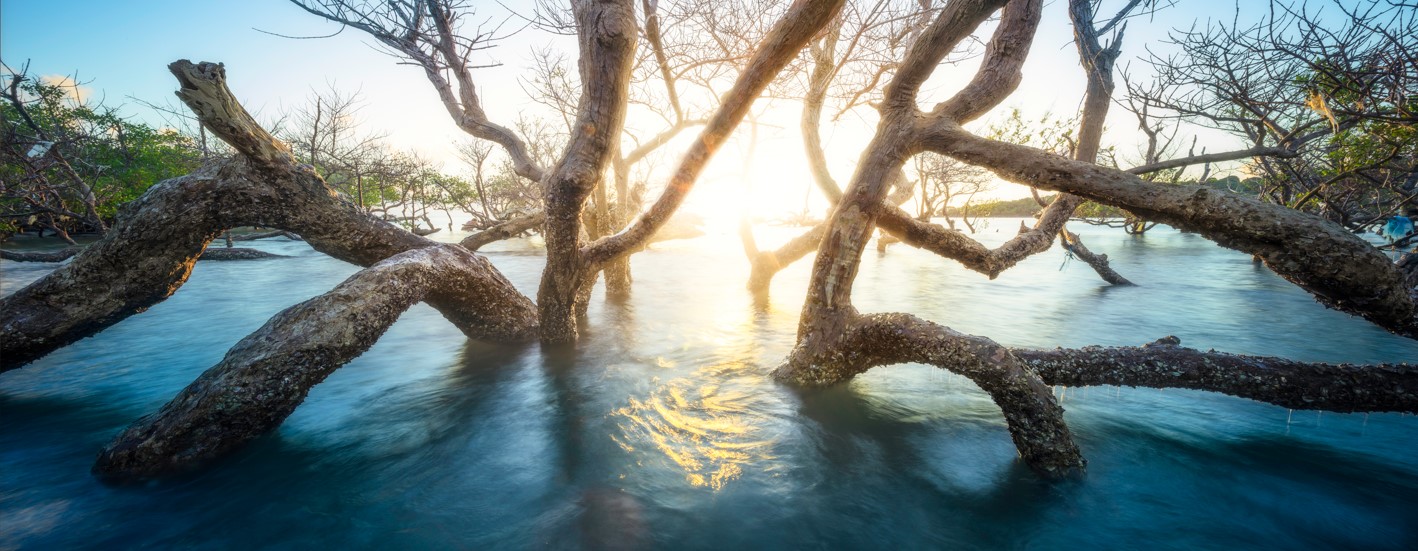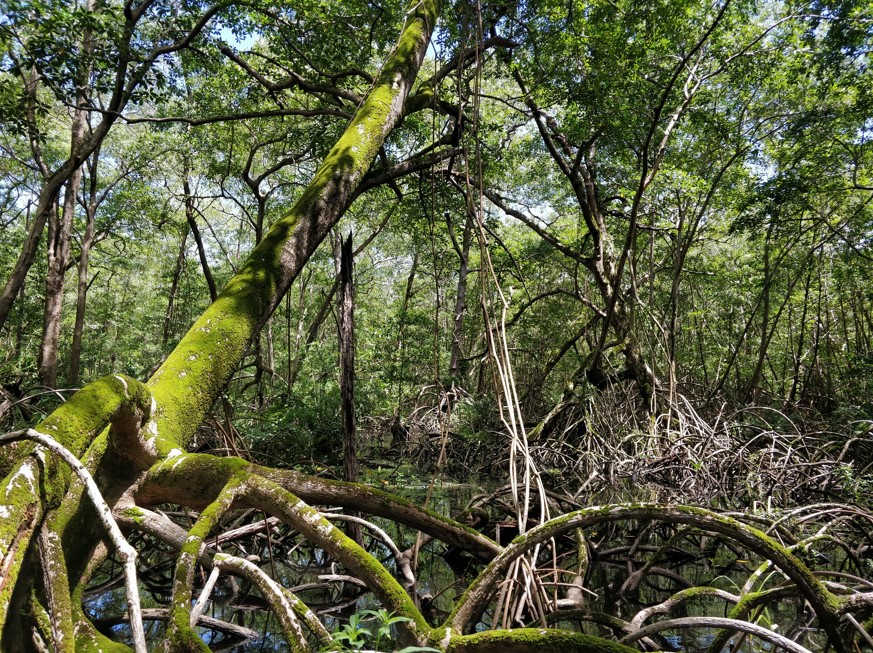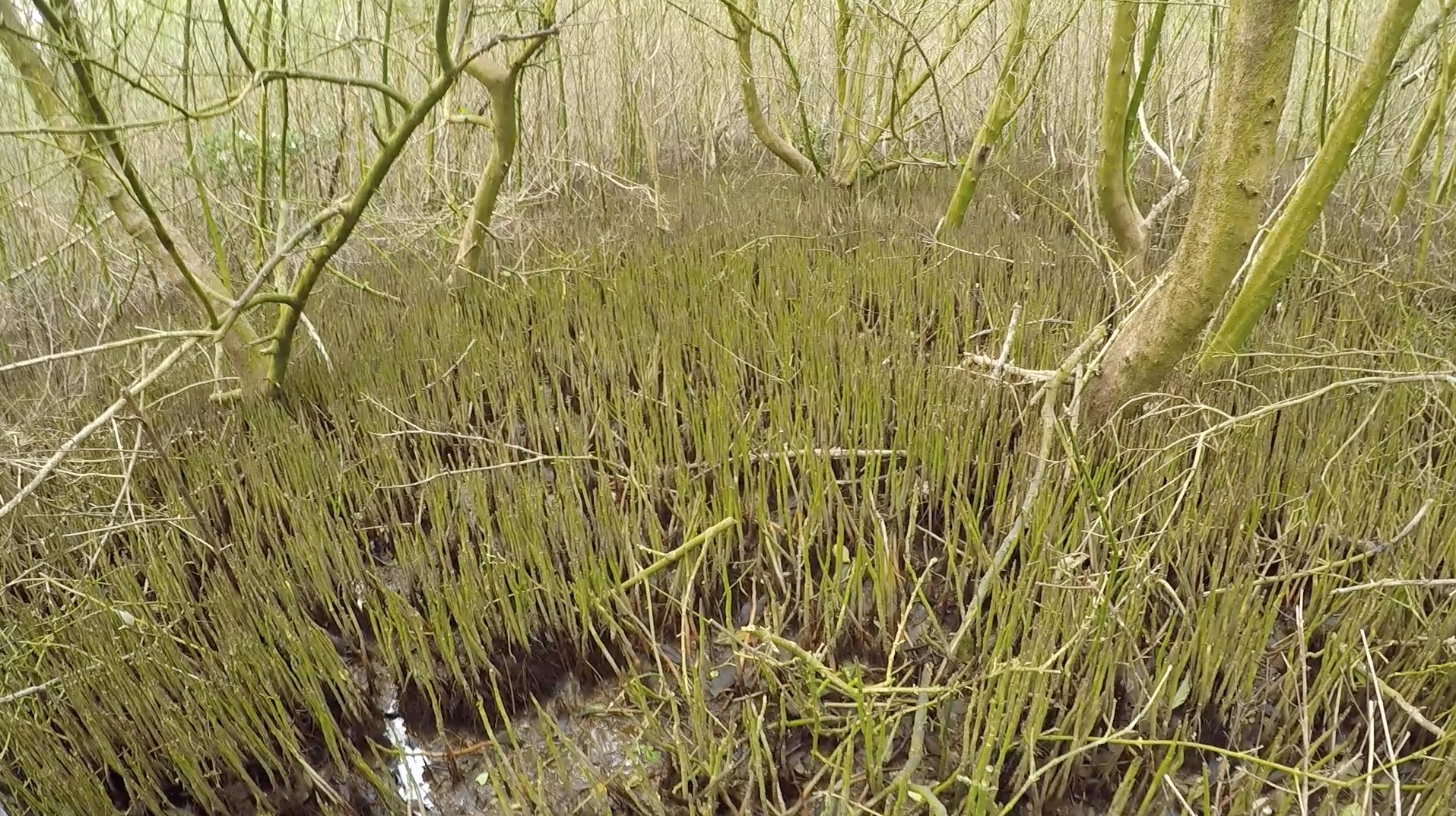
When people think about mangroves, they often associate them with the smell of rotten eggs and with swarms of mosquitoes. While they do create a peculiar odour and perhaps host some unpleasant insects, these unique forests are amongst the most valuable ecosystems on the planet. Mangrove trees typically thrive in harsh environments, surviving hot, muddy, and salty conditions at the margin of land and sea in many tropical and subtropical regions. Mangroves provide a wealth of ecosystem services including essential habitats for many animals, helping filter pollutants, and shielding the coast from waves and storms. Moreover, mangroves play a crucial role in combating climate change, as they capture and store carbon from the atmosphere. In fact, these forests sequester carbon faster than most land ecosystems.
How do mangroves capture and hold on to so much carbon?
Mangrove trees grow fast, storing large amounts of carbon within their living biomass (Fig. 1). Dead roots and leaf litter also accumulate within the—largely anaerobic—mangrove soils, where the decomposition of organic material is very slow and can persist for hundreds of years or even longer. And, because of their unique location as a link between land and sea, mangroves can trap material that is imported by rivers and tides, capturing carbon transported from both upstream catchments and the ocean. Mangroves are very effective at trapping carbon because of their complex root systems. The aerial roots that allow mangroves to survive frequent flooding also slow down tidal currents and therefore allow the trapping of carbon-rich sediments (see Fig. 2). Because of this, mangroves are among the world’s most carbon-rich ecosystems, accounting for 14 per cent of carbon sequestration by the global ocean.
Nevertheless, mangroves are heavily threatened, having been impacted by degradation and deforestation, with 20–35 per cent of global mangrove extent lost over the last 50 years. This loss is primarily driven by expanding agriculture and aquaculture, and ongoing urban development. Climate change and ocean warming are exacerbating these losses from land-use change. Sea-level rise is expected to impose additional stress on these already vulnerable ecosystems, as it can result in drowning of mangrove trees. Mangroves grow well under regular inundation by tides, but they cannot survive prolonged flooding. As dead roots, leaves, and branches accumulate within their muddy soils, mangroves gain elevation, and the build-up of dead plant material creates carbon-rich sediments. If mangroves keep up with sea-level rise by accumulating carbon-rich plant material in their soils, then carbon stocks can increase. However, if sea-level rise outpaces mangrove soil buildup, then tree mortality will reduce carbon storage.
Clearly, mangrove environments and the processes determining changes in carbon stocks are highly complex. To predict whether, and how much, carbon will be sequestered by mangroves in the future, we need to improve our understanding of these delicate systems.

Figure 1. Mangroves store large amounts of carbon within their living biomass.
Understanding carbon accumulation in mangroves over time
At the University of Exeter, we apply different methodologies to investigate the development of mangrove ecosystems and their response to natural and anthropogenic drivers. We are collecting empirical data from different field sites in Colombia where mangrove trees can reach up to tens of metres in height, making these forests true carbon storage hotspots. Sediment corers are used to obtain soil samples up to 5 metres deep. In the laboratory, we determine the age of sediments and then determine their carbon content, enabling an estimate of the rate of carbon accumulation over the past decades to centuries. We are conducting these analyses at sites that are subject to different management strategies: some sites are protected and others are not. This means we can examine the effectiveness of conservation measures, and we have already found that protection can help to limit anthropogenic disturbance, improve forest structure, and increase biomass carbon stocks. Results also suggest that sediment carbon stocks are controlled by longer-term processes that are likely to pre-date the implementation of protective measures. To understand such longer-term changes in mangrove forest development and carbon burial, we use microscopic plant remains preserved in the soil to discover any potential changes in dominant mangrove species and whether this has influenced carbon accumulation.
In addition to investigating their history and current status, we are developing computer models to simulate the future responses of mangroves to sea-level rise and their ability to continue sequestering carbon. Through models, we can explore the effects of different IPCC climate change scenarios and human interventions, such as the building of upstream dams, that reduce sediment supply to coastal systems. Our model simulations indicate that increasing rates of sea-level rise trigger drastic losses in the mangrove carbon sink because of tree mortality, decomposition of organic matter, and erosion of carbon-rich soils. Increasing availability of sediments generally enhances mangrove resilience and thus carbon storage. These computer modelling insights can help us to unravel the multiple potential responses of carbon dynamics to changing environmental conditions.

Figure 2. The aerial roots of mangroves are effective at trapping sediment and associated carbon.
Given the crucial importance of mangrove ecosystems as carbon sequestration hotspots, new research approaches are needed to help develop sustainable management and conservation strategies. In parallel, given that these natural ecosystems are inherently linked to human activity, an ongoing dialogue between research institutes, NGOs, governments, local communities, and other stakeholders is needed. These discussions should also address mechanisms to finance mangrove protection, especially because mangroves can play a key role in meeting national-level climate mitigation goals and help to achieve the Paris Climate Agreement goal of limiting global warming.
• Barend van Maanen (B.Van-Maanen@exeter.ac.uk) and Dunia H. Urrego (D.Urrego@exeter.ac.uk)
Department of Geography, University of Exeter, UK.
Acknowledgements: The mangrove research at the University of Exeter mentioned in this article is funded by the UK Natural Environment Research Council under project NE/V012800/1.
